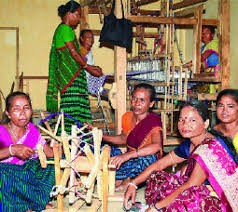Tribal welfare: GI tag can help ST entrepreneurs thrive
- At this critical juncture of India’s development journey, where inclusive economic growth has emerged as a new exemplar of development, the empowerment of scheduled tribes (ST), which are largely economically and socially backward, has assumed special significance. And what better way than to help them become self-employed entrepreneurs.
- Major chunk of the scheduled tribe population—tribal cultivators and artisans—already belong to the self-employed category. In fact, according to the Periodic Labour Force Survey (PLFS) 2018-19 report, a large proportion of scheduled tribe workers (57%) are self- employed, basically in the agriculture & allied activities and handicrafts.
- Around 30% are casual and agricultural labour, and only around 13% are engaged in salaried employment. Hence, it is essential to explore skilling avenues which would help them earn more in the same occupation.
- Under the circumstances, would the provision of geographical indicators (GIs), which certifiy products as belonging to a geographical location and protects identity, help promote and revitalise traditional production practices and increase the employability of the scheduled tribes? In other words, would the GI tag help the tribes to become entrepreneurs?
- There is no doubt that GI holds the potential for increasing the value and market price of a wide variety of potential GI forest products for local ST communities. Many communities have benefited enormously economically from the GI recognition granted to their traditional products. For instance, post the GI tag, the price of Kadaknath Chicken, a native breed of the Dhar and Jhabua districts in Madhya Pradesh and primarily nurtured by the Bhil tribals, has gone up significantly. Greater awareness about the exotic nature of Kadaknath has resulted in a huge spike in its demand and breeders are making respectable profits.
- Similarly, the GI tagged aromatic Araku Valley Coffee, originally produced by the tribal population of Andhra Pradesh, is now being exported as a premium lifestyle and health product. It has also received global acclaim by winning the Gold Medal for the best coffee pod in the Prix Epicures OR 2018 Award in Paris, France. There are many such success stories.
- Considering the advantages, it is important that states where the tribal population is domiciled, do their utmost to identify and explore how traditional products, which incorporate the knowledge and skills of the scheduled tribes, could qualify for GIs. However, presently states with high tribal population may not rank high in terms of the number of geographical indications.
- Having said so, getting the GI tag alone may not be enough to economically upstage the tribal population. The benefit of the GI registered tribal product, in many cases, accrues not to the artist but to traders or middlemen. Second, traditional hand-woven designs are often duplicated and sold at a lower price through mass production, which deprives the tribes of their legitimate income.
- A case in point is the GI registered unique hand-woven embroidery and textile designs made by the Toda tribe of the Nilgiris. Third, marketing and brand promotion is an issue. The GI tag enhances the value—in terms of sales and profits—of only those products which are known, are already profitable, and the enhanced revenue reaches the actual producer of the traditional product.
- Hence, it should be ensured that the provisions of GI are strictly implemented and any infringements, such as cases of proliferation of duplicate and fake products, are dealt with severely. Moreover, there is a need to upgrade the GI Act, 1999, and make it more inclusive and responsive to ground realities so that more products are GI registered.
- It is also critical that NGOs and corporates support the branding and marketing of GI products. In fact, the credit for establishing Araku Valley coffee as an international brand owes essentially to the marketing efforts of an NGO and select corporates. This transformed the lives of adivasis in the area. Government support also helps. For instance, Kadaknath chicken was promoted by the government of Madhya Pradesh and has contributed towards tribal uplift. Many such cases can be cited.
- Further, an enterprise-facilitating platform such as a chamber of commerce, governmental help desk or a voluntary organisation dedicated to GI must be constituted. This would help connect the buyer with the original seller/tribal, thereby helping in reducing the exploitative gap between owner and seller within the GI ecosystem. The inclusion of legal support services within the chamber and voluntary organisations also helps protect the rights of tribes.
- At a time when the government is working on the ‘One District, One Product’ plan and considers the use of GI tag for better results, the experience of scheduled tribes could help.

